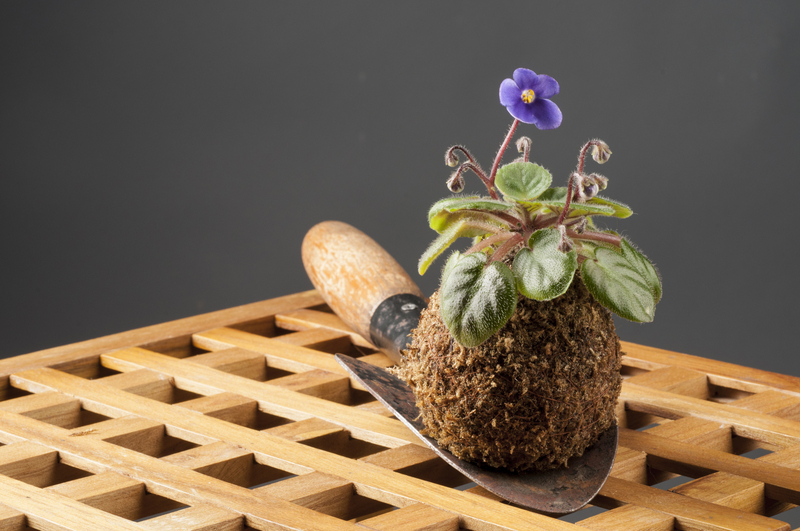Unleashing the Secret Trio of Weed Control Tactics
Posted on 22/06/2025
Unleashing the Secret Trio of Weed Control Tactics
Weeds are the ultimate adversary in any garden, farm, or landscape. They sneak into our flower beds, choke vegetable patches, and reduce crop yields. Yet, amidst the endless battle with invasive plants, a secret trio of weed control tactics stands above the rest. Employing these techniques can drastically reduce weed populations, enhance plant health, and create a flourishing, weed-free environment. In this comprehensive guide, we'll unlock the secrets behind effective weed control strategies and how to implement them for sustainable results.

Understanding the Enemy: Why Do Weeds Thrive?
Before diving into the best weed control methods, it's crucial to understand why weeds are so persistent. Weeds are plants that have adapted to thrive in disturbed soils. Their rapid growth, prolific seeding, and resilient nature make them formidable competitors for nutrients, light, and water.
Common Characteristics of Weeds
- Fast Growth: Many weeds grow faster than cultivated plants, enabling them to outcompete for sunlight.
- Abundant Seed Production: A single weed can produce thousands of seeds in a season.
- Persistence: Some weeds spread through not only seeds but also roots, stems, or runners.
- Adaptability: Weeds tolerate harsh conditions, poor soils, and drought.
By grasping these traits, gardeners and farmers can develop intelligent weed management tactics that disrupt the weed life cycle and minimize their impact.
The Secret Trio of Weed Control Tactics
What if you could significantly reduce weeds without resorting to endless pulling or harmful chemicals? The answer lies in combining three time-tested weed management strategies:
- Prevention
- Physical Control
- Biological or Cultural Control
This "secret trio" forms an integrated weed control plan that yields long-term results. Let's examine each tactic and see how to put them into action.
1. Prevention: Stop Weeds Before They Start
The wisest approach in any weed control strategy is prevention. By taking steps to avoid weed introductions and establishment, you save time, money, and effort in the long run. Here's how to practice preventative weed management:
Effective Preventative Tactics
- Use Clean Tools and Equipment: Always clean tools, boots, and machinery before moving from infested areas to weed-free zones to avoid transporting seeds.
- Inspect New Plants and Mulch: Only plant nursery stock that is free of weeds, and inspect mulch or manure for weed seeds.
- High-Quality Seeds and Soil: Use certified weed-free seeds and compost.
- Timely Watering: Water only the roots of your desirable plants to discourage the germination of surface weed seeds.
- Mulching: Apply a thick layer of mulch to prevent sunlight from reaching weed seeds below, inhibiting their growth.
Did you know? Many invasive weeds arrive through contaminated gardening products or compost. Meticulous sourcing is your first line of defense!
Mulching: The Gardener's Best Friend
One standout method in weed prevention is mulching. Organic mulches like wood chips, bark, straw, or leaves create a physical barrier and improve soil health. Inorganic mulches (landscape fabric, gravel) are also effective, especially for perennial beds and pathways.
- Suppresses weed seed germination
- Conserves soil moisture
- Regulates soil temperature for plant health
Pro tip: Always weed thoroughly before mulching. A 2-4 inch layer will smother most weed seeds and provide lasting protection.
2. Physical Weed Control: Hands-On Solutions
Sometimes, prevention isn't enough. That's where physical weed control techniques come in. Though often labor-intensive, they are highly effective and eco-friendly.
Popular Physical Weed Removal Methods
- Hand Pulling: Best for isolated weeds or delicate areas. Remove the entire root to prevent regrowth--especially vital for persistent perennial weeds.
- Hoeing and Cultivating: Use a sharp hoe to cut annual weeds at soil level. This works best when the weeds are young and the soil is dry.
- Mowing: Regularly mowing your lawn or field will prevent weeds from seeding and reduce their vigor.
- Flame or Thermal Weeding: Carefully pass a flame weeder over the ground, which damages weed foliage and prevents regrowth. Suitable for driveways, paths, or between rows.
Timing matters: Early removal of seedlings is critical before they drop seeds. For persistent weeds like dandelions or bindweed, repeated removal will eventually exhaust their energy reserves.
Physical Barriers and Landscape Fabric
Using landscape fabric is a popular way to suppress weed emergence. Placed beneath mulch, it physically blocks weed growth from below while allowing water and air to reach plant roots.
- Ideal for: Permanent beds, vegetable gardens, and under gravel paths.
- Maintenance tip: Replace or repair tears in fabric to maintain protection year after year.
Remember: No method guarantees 100% weed eradication, but combining these techniques leverages their strengths for superior weed management.
3. Biological and Cultural Controls: Working with Nature
The third, and perhaps most powerful, member of the secret weed control trio is using nature itself. Biological and cultural weed control exploits the natural relationships between plants, soil, and the ecosystem to outcompete or suppress weeds.
Cultural Practices for Weed Suppression
- Dense Planting: Planting crops or ornamentals close together forms a living mulch, shading weeds and reducing open soil for seeds to germinate.
- Crop Rotation: Rotating different crops disrupts the life cycle of weeds adapted to one plant type.
- Cover Crops: Sowing "green manure" crops (like clover or rye) during off-seasons covers the soil, fixes nutrients, and suppresses weed emergence.
- Proper Mowing Height: In lawns, setting your mower higher shades out many weed seedlings and strengthens grass health.
Interplanting or companion planting with vigorous groundcovers or fast-growing annuals can dramatically minimize weedy invaders.
Biological Control: Harnessing Beneficial Organisms
Biological weed control involves introducing natural predators, insects, or microbes that target specific weed species. While widely used in agriculture and large-scale restoration, this technique requires careful research to avoid negative impacts on native flora or fauna.
- Insect Allies: Certain beetles or moths can reduce populations of invasive thistles, knapweeds, or St. John's wort.
- Pathogenic Fungi: Commercial weed biocontrol agents incorporate fungi that specifically attack weed roots or leaves.
Biological solutions are evolving rapidly. Always consult with local agriculture agencies before introducing new species.
Combining the Trio: The Power of Integrated Weed Management
The real "secret" lies in blending all three weed control tactics into integrated weed management (IWM). Instead of relying on just one approach, integrating prevention, physical, and biological controls achieves robust, lasting results. Here's why:
- Diversify your defenses: Weeds adapt quickly to single-method solutions, but a combined strategy keeps them in check year-round.
- Reduce chemical dependency: A coordinated weed management plan minimizes the need for herbicides, fostering a healthier garden and ecosystem.
- Encourage healthy plants: Every weed kept out means more nutrients, water, and sunlight for desirable plants.
- Long-term success: Integrated weed control builds resilient soil and plant communities that resist further invasion.
Getting Started: Step-by-Step Weed Control Guide
Ready to put the secret weed control trio into action? Follow this practical plan:
- Survey Your Property: Identify target areas, weed species, and sources of infestation.
- Implement Prevention Measures: Clean tools, inspect new materials, apply mulch, and tighten garden borders.
- Physically Remove Outbreaks: Hand pull or hoe visible weeds, especially persistent perennials.
- Enhance Soil Health: Amend soil with compost and plant dense, vigorous crops or groundcovers.
- Monitor and Maintain: Regularly check for new weeds, repair barriers, and rotate crops or mulch annually.
Patience is essential! Over time, these combined methods result in fewer and fewer weeds, creating cleaner, healthier landscapes without the constant struggle.

Frequently Asked Questions on the Secret Trio of Weed Control
A: While no method guarantees permanent eradication, the secret trio of weed management greatly reduces weed pressure and gives your plants the upper hand.
A: Yes, prevention, physical removal, mulching, and biological/cultural controls are considered organic gardening practices.
A: Replenish organic mulch once or twice a year, or whenever the layer becomes thin and soil is visible.
A: When used properly, landscape fabrics can suppress weeds while allowing air and water to reach roots. Be sure to periodically check beneath fabric for soil compaction or pests.
A: For small areas, hand removal works well. For large fields, combine with mulching, mowing, and cover cropping for manageable maintenance.
The Bottom Line: Weed-Free Success with the Secret Trio
Weeds don't have to rule your garden. By embracing the "secret trio" of weed control tactics--prevention, physical control, and biological/cultural methods--you'll win the war on weeds. Not only will you cultivate healthier plants and soil, but you'll employ long-term, environmentally responsible techniques that stand the test of time.
Unleashing the secret trio of weed control isn't just about pulling more weeds; it's about outsmarting them, working with nature, and building a resilient, vibrant landscape where desirable plants thrive. Begin your integrated weed management journey today, and say farewell to weeds--naturally!
Related Search Queries
- Integrated weed management strategies
- How to control weeds without chemicals
- Mulching for weed prevention
- Best physical weed control techniques
- Cultural weed suppression practices
- Creating a weed-resistant garden
If you found this guide to weed control tactics useful, share it with fellow gardeners and subscribe for more sustainable gardening solutions!

